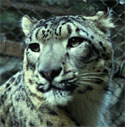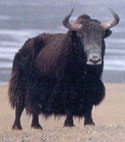
Plateau Marvels
the Blue Poppy, Bhutan's national flower
The defining element of the Tibetan plateau is its extreme altitude, with average elevation hovering at 4,000 metres. The plateau is home to the world's highest peaks and its deepest valleys. Like going to depth in the ocean, rising to altitude is an alien environment with extreme weather conditions. To survive at such altitude requires special adaptations on the part of flora and fauna, leading to some extraordinary specimens. In this high-altitude world, fauna and flora survive in a delicate balance—one that is easily upset. Any damage done to this fragile environment could take a very long time to restore.
click on images below to enlarge
The blue poppy
The national flower of Bhutan is the Meconopsis grandis, the tallest of the half-dozen varieties found in the country. Meconopsis grandis grows to about a metre in height at altitudes of over 4,000 metres in alpine scree. The brilliant blue poppy is such a hardy species that the hairs growing on its stem have been observed coated in ice. A perfect Meconopsis grandis radiates a brilliant blue. No blue can compare with the blue of this poppy, says Canadian poppy expert Bill Terry. He says that among plants, none display such a palette of primary colours as the Asiatic poppies—the deep red of punicea, the buttery yellow of integrifolia, or the imperial purples of lancifolia and delavayi.

Yartsa Gunbu
Is it an insect? Is it a plant? Well, half-way between. Yartsa gunbu is the caterpillar of the ghost moth, which is attacked by a fungus that metamorphoses it. The resulting specimen, known as Chinese caterpillar fungus, 'grows' in surface soil at around 4,000 metres and is highly valued in Tibetan and Chinese traditional medicine as a general health enhancer and tonic. Annual 'collection' of yartsa gunbu provides significant income for Tibetan nomads.

Snow Lotus
This rare plant (aka saussurea) grows at elevations of 3500 metres to 5000 metres across the Himalayas. Varieties range from a tall thistle-like plant to a dwarf alpine species. The plant is collected by nomads at the same time as they go foraging for mushrooms in the spring. The snow lotus is dried for several months after collection. It is prized for its medicinal properties—said to counter altitude sickness, arthritis and colds.

Bar-Headed Goose
Astronauts on the wing: these incredible birds fly at altitudes up to 9,000 metres, clearing the Himalayas twice each year to complete an epic migration. How they still manage to see and breathe when flying long distances in such extreme conditions remains a mystery. After winter is over, the geese leave their feeding grounds in the lowlands of Nepal and India, going from near sea-level straight up to 8,000 metres, heading over the Himalayas to breeding grounds in Amdo (Qinghai Lake), Outer Mongolia, and Kyrgyzstan. An inner layer of down feathers helps stop the bird from freezing to death, while an outer layer of tightly woven feathers apparently waterproofs the goose and prevents build-up of body ice that would cause the bird to plunge to its doom. The bar-headed goose has been clocked flying at 80 km/hr, but with a tailwind it can rocket along at speeds up to 160 km/hr.

Snow Leopard
The snow leopard is such a stealthy cat that movie film capturing it in action was not taken until this century. The cat is about the size of a large dog, and has an enormous bushy tail that serves to balance its movements over snowy terrain. Large pads on the feet act like snowshoes. The snow leopard lives above 3,500 metres, and can range over passes above 5,500 metres. The snow leopard has disappeared from much of its range in Tibet due to hunting, but survives in pockets of Ladakh and in the western Himalayas.

Wild Yak
A wild yak, or drong (inTibetan) is an enormous creature: an adult male can weigh up to 1,000kg (equivalent to double the weight of a domestic yak), and can stand almost 2m high at the shoulder. Wild yaks graze on grass, herbs, moss and lichen. They are sure-footed over rough terrain: herds travel on snow in single file, carefully stepping on footprints left by the lead yak. The wild yak's long shaggy coat enables it to withstand violent winds and snowstorms. In the 1940s, herds of thundering wild yaks could be sighted in northern Tibet, but wild yaks are rarely spotted today, and only in small numbers. Wild yaks were killed by the truck-load for meat by Chinese troops and settlers.

Tibetan antelope
The Tibetan antelope (chiru in Tibetan) inhabits high desert plateau. The females are hornless, but the males sport a pair of long slender upright horns, which could make the antelope the source of unicorn myths in Tibet that date back several centuries (viewed in profile, the chiru would appear to have one long horn). The chiru's fine wool is a special adaptation that traps layers of warm air close to its body so it can survive snow blizzards where the thermometer plummets to -40°C. The chiru's underwool, known as shahtoosh, is the finest animal fibre in the world. In Kashmir, shahtoosh was woven into shawls intended for high-end fashionistas in the west as the shawls are incredibly warm yet light. The weaving trade was banned in Kashmir after it was revealed that the only way to get shahtoosh is by killing the antelope. Although the trade in shahtoosh is illegal, it has pushed the chiru to the brink of extinction, with fewer than 100,000 remaining. Their last hope is the creation of a Changtang nature reserve.
 Snow Lions, bounding from peak to peak |